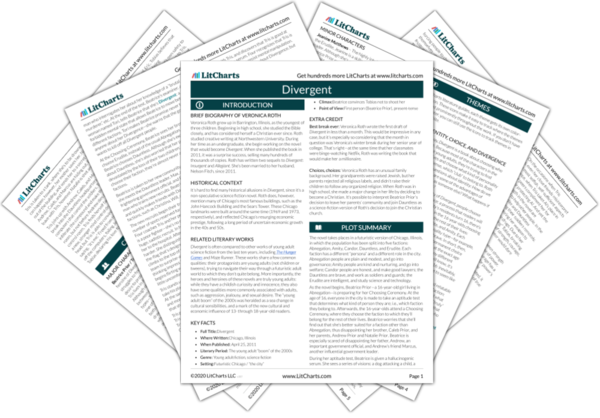Summary
Analysis
An unnamed narrator describes a mirror, which her “faction” allows her to look at every three months, while the narrator’s mother cuts her hair. On one such day, the narrator’s mother cuts the narrator’s hair and whispers, “Today is the day”: today, the narrator will be sorted into one of five factions. The narrator, who’s 16, wonders if she’ll have to leave her mother, brother, and father soon.
It’s notable that the book begins with a description of a mirror: a classic symbol of self-contemplation and identity. The mirror signals us that this will be a book about understanding oneself—the process of self-examination that goes along with any coming-of-age story. It’s also important to note that the mirror—also a symbol of vanity—is a novelty in this narrator’s life, suggesting that her society is opposed to such “luxuries.”
Themes
The narrator thinks about the “Abnegation” community she lives in: a community in which “self-indulgence” is condemned. People in this community don’t celebrate birthdays or wear attractive clothing. Secretly, the narrator fantasizes about leaving this community, but she feels guilty for her feelings.
A short while after having her hair cut, the narrator sits in a bus with her brother, Caleb. Caleb, who’s less than a year older than the narrator, and therefore also headed to his aptitude tests that day, is a selfless, humble man, despite his good looks—in other words, he’s an ideal man for the Abnegation community. The bus takes Caleb, the narrator, and others to the ruins of the Sears Tower (a famous building in Chicago), now known as the Hub.
This section introduces the setting of Roth’s story, contrasting the real (the Sears Tower is a real building) with the imaginary (this Puritanical, rigidly divided society). Caleb and the narrator’s community is defined by a kind of forced modesty: even though Caleb is attractive, his community forces him to deny this fact.
Themes
Inside the Hub, Caleb and the narrator usually attend school. Today, however, their classes have been shortened to make room for a “Choosing Ceremony” in the afternoon. In the morning, the narrator goes to classes on Faction history and other subjects. She thinks about the aptitude test she’s about to take: a test that will sort her into one of five groups. The groups are: Abnegation (the group she lives in right now), Candor, Erudite, Amity, and Dauntless. The narrator goes to school with members of these other groups. In between classes, an “Erudite” boy pushes her to the ground.
It’s easy to see that Divergent is intended for a teenaged audience: this passage is essentially a description of a day at high school. Just like at any high school, the students separate into “cliques”—jocks, nerds, etc. The conceit of this novel is that high school cliques have become the basis for an entire society: the city of Chicago has divided into cliques (or factions), whose members are fiercely loyal to one another, and competitive with each other.
Themes
Get the entire Divergent LitChart as a printable PDF.

The narrator considers another one of the groups, the Dauntless. Every day, Dauntless people are supposed to prove their bravery by jumping from a moving train. Their job is to protect the city, though the narrator doesn’t know from what.
Roth ends her chapter on a note of mystery: clearly, the city needs to be defended, but from whom or what we have no idea. Given that people don’t know who their own enemies are, defense probably isn’t such an urgent problem. This points to the idea that the city’s groups or cliques don’t necessarily serve any practical purpose (i.e., defense from an enemy), so much as they create a “herd mentality” and keep everyone following the rules.
Themes












